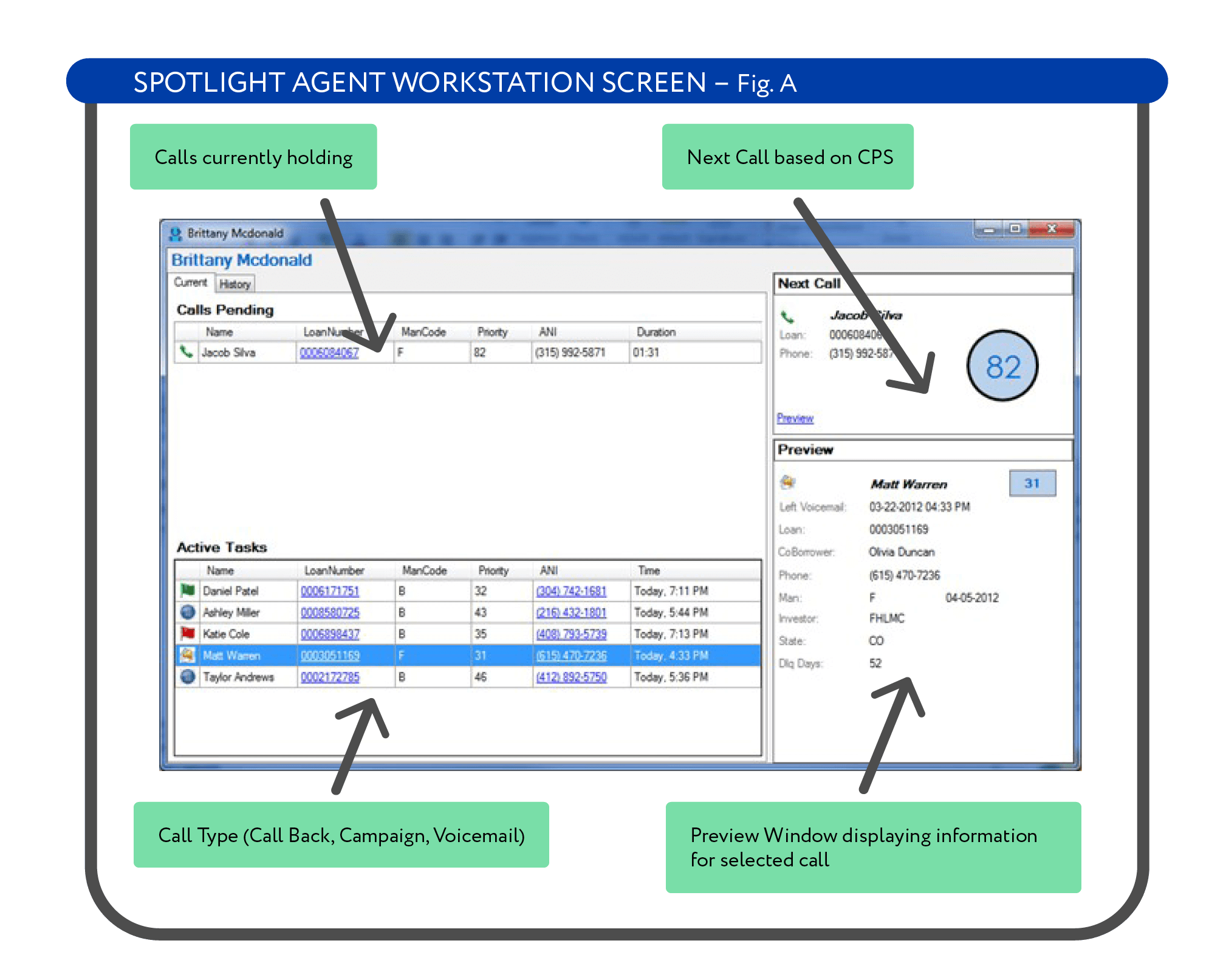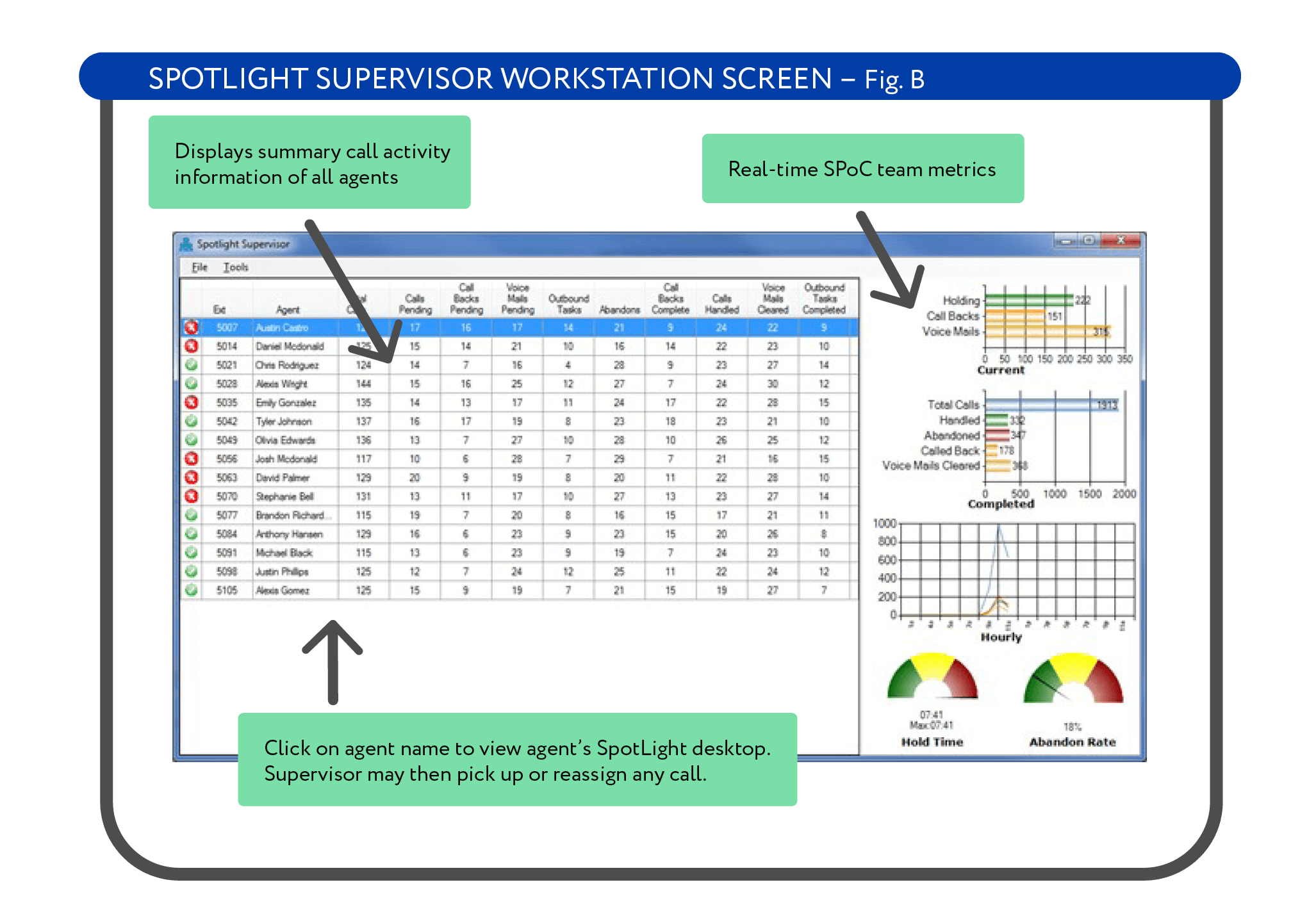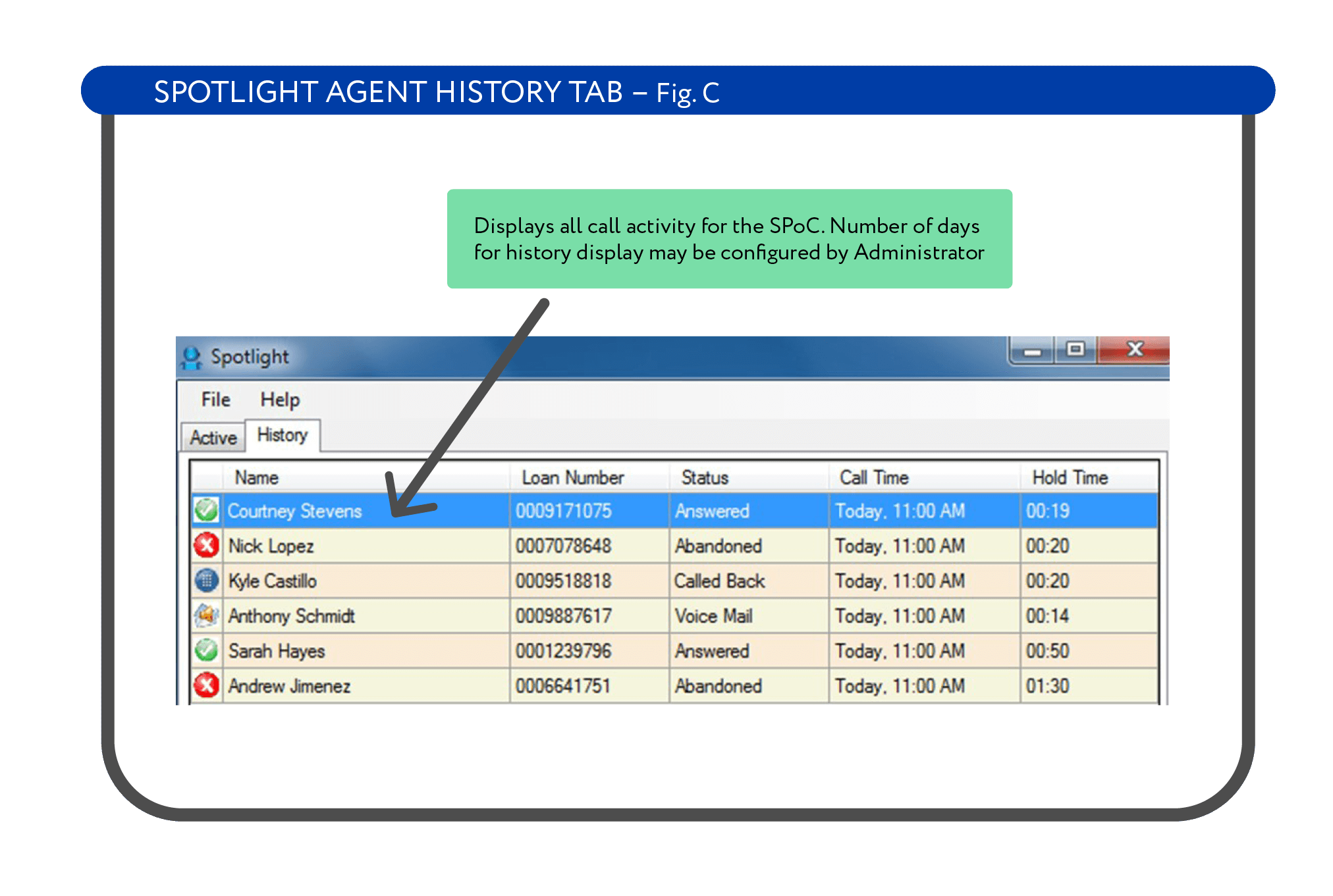
Many contact centers assign Single Points of Contact (SPoCs) to customers who have unique characteristics. Generally, these are customers with complex problems who need the ongoing assistance of a specialized agent – one who works with the customer over a span of days, weeks, or even months, to understand and resolve their issue.
The personal attention of a SPoC ensures the customer has continuity through their process and circumvents the pitfalls from having to bring different agents up to speed. However, SPoC calls are not easily managed using traditional contact center systems. teleVoice SpotLight™ is the only patented call management solution designed specifically for SPoC agents. This document outlines the issues that must be considered when setting up SPoC call center processes and how a SpotLight implementation will address these issues.
Whether the servicer defines a SPoC as a single agent or as a small group of agents, certain call processing problems may be expected to arise. The following issues must be considered in developing a call management strategy:
The traditional approach to managing inbound call traffic in a call center involves the use of one or more Automatic Call Distributors (ACDs). These telephony systems allow calls to be disbursed evenly among agents in a group. When no agents are available, callers are placed on hold. As agents become available, calls are transferred to agents on a first-in, first-out basis. Thus, callers may be told, “Your call will be answered in the order received.”
ACDs work very well in call centers in which any caller’s needs can be addressed equally well by any agent. However, in a SPoC environment, ACDs fail to adequately address the challenges detailed above.
Creating a SPoC process using ACD technology will result in:
The patented SpotLight SPoC Call Management solution has been designed to address the major problems associated with SPoC by:
With SpotLight, agent resources are maximized, and customer needs are addressed more effectively. Using proprietary technology designed specifically for SPoC environments and leveraging the store of data on the organization’s (credit union, bank, mortgage provider, or other company) data platform(s), SpotLight facilitates intelligent prioritization of inbound and outbound calls. For each call, a Call Priority Score (CPS), based upon account data and call characteristics, is dynamically calculated. Critical calls may be handled first, and less urgent calls may be scheduled for later handling.
The teleVoice SpotLight solution does not replace the existing IVR system, phone system, or voicemail system. Rather, it interfaces with the existing call center systems to provide enhanced functionality through several components.
Calls identified (by the existing IVR or by Customer Service) as assigned to a SPoC are transferred to the SpotLight IVR. Based upon the organization’s defined call management process, the IVR presents menu options to customers as they hold for an agent. The SpotLight IVR queues callers until their calls are transferred to agents, they abandon, or they request other services.
SpotLight Agent Workstation is a software package that resides on each SPoC agent’s desktop. It provides views of all pending inbound and outbound calls with detailed information on each call.

SpotLight Supervisor Workstation is a software package that resides on each SPoC supervisor’s desktop. It provides a dashboard summary of all pending and processed calls for assigned SPoC agents. A graphical display delivers snapshot views of key analytics.
SpotLight Server software may reside on the SpotLight IVR server or on an independent server. It is the engine that associates customer data with calls and manages the prioritization of inbound and outbound call opportunities for each SPoC agent.
SpotLight Report Server is a reporting package that resides on the same server as the SpotLight Server. It produces on-demand and scheduled reporting from the SpotLight call traffic data store.
Customers who have been authenticated and require a SPoC agent are transferred to the SpotLight IVR from the existing IVR or Customer Service. SpotLight IVR captures account data from the host data platform(s) and presents appropriate scripting. Customers may be immediately transferred if an assigned SPoC agent is available. Otherwise, they may be presented options for hearing account information, waiting for their agent, scheduling an agent call back, or being transferred to their agent’s voicemail. Callers who continue on hold will be presented appropriate options at defined intervals.
SpotLight Agent Workstation displays a constantly updated view of all calls on hold, scheduled call backs, and voicemails. Each call entry includes a number of data elements, including Customer Name, Account Number, Call Priority Score, Phone Number, Hold Time, and other account information. A Preview window displays even more pertinent data on any selected call. Agents may click on a borrower’s phone number to be connected (if a caller is in queue) or to outdial to a caller (in the case of a scheduled call back). Agents may also create scheduled call backs, transfer callers to supervisors, or clear voicemails.
Supervisors may view performance data related to all supervised SPoC agents. Data for each agent includes: Total Calls Received, Calls Holding, Call Backs Pending, Voicemails Pending, Abandons,
Inbound Calls Handled, Call Backs Completed, and Voicemails Cleared. Supervisors may select any agent to view that agent’s SpotLight Agent Workstation display. Any call may be processed by the supervisor in place of the agent. Supervisors may also reassign calls to other agents. Supervisors may be given the ability to allow selected (or all) agents to override CPS and select a call “out of order.” Additionally, supervisors may define agent work days and hours. Calls may be assigned to other agents when agents are out of the office (vacation, sick days, etc.).

The SpotLight Report Server maintains data on each call in a SQL database. Standard reporting includes Summary Call Activity Report, Contact Report (by account number), Summary Contact Report (by agent or group), and Detailed Contact Report (by agent or group). Reports may be produced for any date range. Captured call activities include date/time call received, call duration, IVR options presented, IVR options selected, date/time of transfer to agent, date/time call back was requested, date/time of call back, voicemail transfer, and hangup. Custom reports may be easily generated using standard SQL reporting tools.
The SpotLight System Administrator has the ability to set and edit a variety of operational configurations, including CPS scoring parameters, call timing thresholds, data display elements for agents and supervisors, report options, and the like.
SpotLight has been developed with the flexibility to accommodate the call management requirements unique to each organization. SpotLight features may be customized.
Any of the following menu options may be offered to callers holding for a SPoC agent:
There are a few different choices for determining the order in which calls should be processed:
Agents may be assigned outbound call tasks in addition to handling inbound calls and scheduled call backs. Multiple campaign types may be assigned to allow for in-depth campaign reporting. Campaign calls may be assigned target call back thresholds (based upon campaign type) and scored accordingly for CPS ranking.
If desired, the SpotLight IVR may tell the caller, “Your assigned representative, John Smith, is assisting another caller.”
Customers may be given an option to be transferred to their SPoC agent’s voicemail. These events are tracked in the SpotLight Agent Workstation.
Customer account data may be automatically displayed when agents accept inbound calls or place outbound calls. Screen pops can also be used for previewing customer information prior to accepting inbound calls or placing outbound calls. teleVoice “pops” the preferred data screen from the host data platform used for managing their account.
Spotlight may capture loan-level data from one or more data sources using a variety of interface methods. If desired, SpotLight may log defined call events to a host data platform.
By reducing hold times, abandons, and “shoot in the dark” outdial attempts, both customer and SPoC agent time are used more effectively.
Complex issues may be handled more efficiently if customers and their SPoCs are able to communicate efficiently. By reducing hold times, abandons, and “shoot in the dark” outdial attempts, both customer and SPoC agent time is used more effectively. Much less time is wasted, and more time can be devoted to the important work of addressing issues.
When customers are experiencing excessive hold times, repeated attempts to reach an agent, or unreturned phone calls, SpotLight provides the ability to immediately generate user-level reporting. With these reports in hand, the organization can defend against false accusations from customers or address an employee performance issue if the accusations are accurate.
By facilitating better two-way communication, SpotLight can improve overall customer satisfaction.
As departments incorporating call management systems and SPoCs continue to grow and evolve, the need for effective performance measurement tools has increased as well. SpotLight Agent Reports can be an important addition to evaluating the efforts of SPoC agents in communicating with their assigned customers.

SpotLight may typically be implemented within 90 to 120 days of contract signing. Typical implementation processes include several client and teleVoice responsibilities.
teleVoice is a leading provider of cloud and software solutions focused on the delivery of conversational, effortless, and secure interactions to the financial services industry. Building on our strong 35+ year heritage and deep industry experience, we enable banks, credit unions, and mortgage companies to improve customer and member experiences.
Contact centers are rich in customer data, which organizations can use to gain deeper knowledge of customer behaviors and trends. Our team works with organizations to adapt and advance contact centers and incorporate customer analytics, feedback and insights they can leverage to improve efficiency and proactivity in addressing customer needs.
Our consultative approach includes professional services from pre-sale design and engineering to implementation. We blend customer data, best practices and technical expertise to help organizations provide better experiences, improve customer satisfaction, and increase agent productivity.
Whether you need an enterprise-wide CTI implementation to provide Screen Pops to multiple call centers or a customized IVR solution, teleVoice is the answer. Blend our experience and innovation with your knowledge of your business, and we’ll have you on the path to improved service levels. On time and within your budget.
Copyright © 2021 teleVoice, Inc. All Rights Reserved.
teleVoice, Inc. logos, and trademarks or registered trademarks of teleVoice, Inc. in the United States and other countries.
Other names and brands may be claimed as the property of others. Information regarding third-party products is provided solely for educational purposes. teleVoice, Inc. is not responsible for the performance or support of third-party products and does not make any representations or warranties whatsoever regarding quality, reliability, functionality, or compatibility of these devices or products.
This document is for informational purposes only and is not a legal opinion. Servicers must review the respective servicing guides and announcements for each applicable state and federal agency to determine specific requirements. Additional review with legal counsel may be needed as well to ensure compliance with the published servicing guidelines and other regulatory guidelines.
The information contained in or supplied with this document is the confidential and proprietary information of teleVoice, Inc. (“teleVoice”) and it may not be copied by or disclosed to any person or entity (other than to the intended recipient), without the prior written consent of teleVoice. teleVoice accepts no liability whatsoever for any consequences arising from the reproduction or use of the information contained in or supplied with this document, or from its disclosure to any person or entity, including to the intended recipient. By receiving this document, the intended recipient agrees it shall not use any part of the information contained in, or supplied with this document, in any way to compete with teleVoice and will take all steps designed to assure its compliance with this provision.